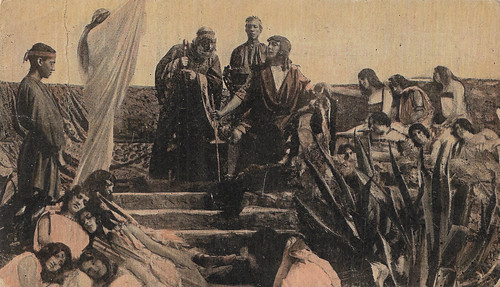
Spanish cromo by Chocolate Salas-Sabadell, no. 2 of 6 cards. Photo: Gaumont. L'esclave de Phidias/The Slave of Phydias (Léonce Perret, 1917), starring Luitz-Morat as the Greek sculptor Phidias, here selecting a new model for his upcoming statue. The Spanish release title was La esclava de Fidias.
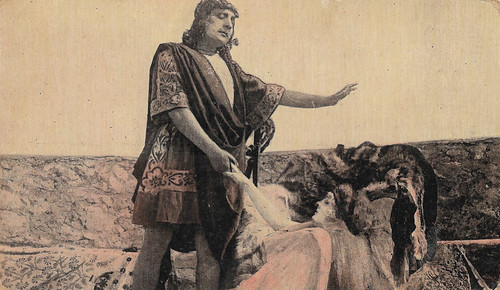
Spanish cromo by Chocolate Salas-Sabadell, no. 2 of 6 cards. Photo: Gaumont. Luitz-Morat as the Greek sculptor Phidias and Suzanne Delvé as the slave Callyce in L'esclave de Phidias (Léonce Perret, 1917).
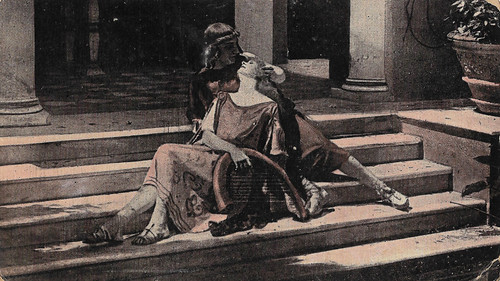
Spanish cromo by Chocolate Salas-Sabadell, no. 3 of 6 cards. Photo: Gaumont. Luitz-Morat as the Greek sculptor Phidias and Suzanne Delvé as the slave Callyce in L'esclave de Phidias (Léonce Perret, 1917).
A long poetic composition for music and images
The flip sides of the Spanish collector's cards contain the plot of L'esclave de Phidias/The Slave of Phydias (Léonce Perret, 1917). The famous Athenian sculptor Phidias has been commissioned to sculpt a statue of Venus. Dissatisfied with his models, he goes to a slave market where he discovers the beautiful slave Callyce. She becomes his model.
Phidias has a jealous lover, the courtesan Quinta. She discovers the love between Phidias and his slave and takes revenge. She has Callyce whipped, while she also steals the gold destined to cover the statue of Venus. Phidias is accused of theft, caught, not believed and exiled for life. Phidias flees by boat together with his beloved Callyce.
In 2016, L'esclave de Phidias/The Slave of Phydias was presented at Il Cinema Ritrovato in Bologna. British film historian Maria Wyke wrote in the festival catalogue: "Perret creates here another of his exquisite pictorial melodramas. Advertised by Gaumont as an 'ancient poem', the film is a long poetic composition for music and images. The studied composition and depth of field of the tableaux recall the seductive antiquity depicted in Alma-Tadema's paintings, bringing it to life.
Much of the film is shot on location on the coast of southern France, among the cedars and cypresses of an elegant neoclassical villa. The characters appear to us streaked with light, reflected in shimmering pools of water, silhouetted against a shimmering sea in images of great emotional intensity. This is not a grandiose historical film about Phidias and the colossal works he created to celebrate the Athenian state. What matters is not the sculptor's creativity but his model, the poor slave girl who gives the film its title. While Phidias attempts to sculpt a statue of the goddess of love that is destined to remain off-screen and unfinished for the duration of the film, the young slave girl arouses true love passion in the artist with the beauty of her complexion and above all the sound of her lyre.
At the end of the film, the lovers face oblivion, forced to say goodbye to the peace of a 'land of love and beauty' that is both ancient Greece and contemporary France. The themes of suffering, loss and exile are in tune with the climate of the First World War, during which the film was shot. At the premiere, which took place at the Gaumont Palace in early 1917, Eugène Poncin conducted his score for soloists, choir and large orchestra composed especially to accompany Perret's 'aesthetic symphony' dedicated to a hapless love against the backdrop of a tragic Hellas."
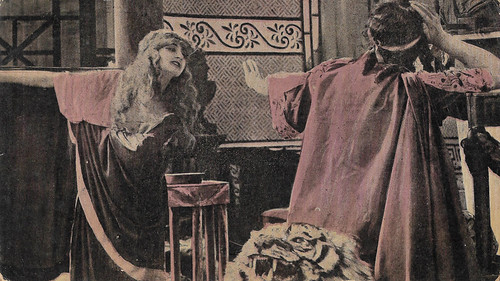
Spanish cromo by Chocolate Salas-Sabadell, no. 4 of 6 cards. Photo: Gaumont. Luitz-Morat as the Greek sculptor Phidias and Suzanne Delvé as the slave Callyce in L'esclave de Phidias (Léonce Perret, 1917).
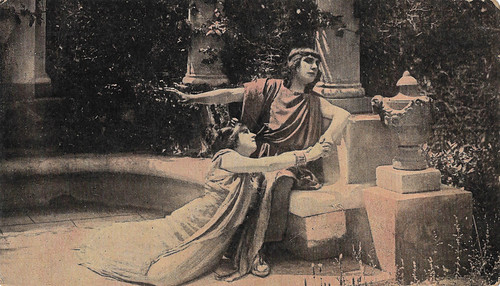
Spanish cromo by Chocolate Salas-Sabadell, no. 5 of 6 cards. Photo: Gaumont. Luitz-Morat as the Greek sculptor Phidias and Madeleine Ramey as the courtesan Quinta, rejected by Phidias, in L'esclave de Phidias (Léonce Perret, 1917).
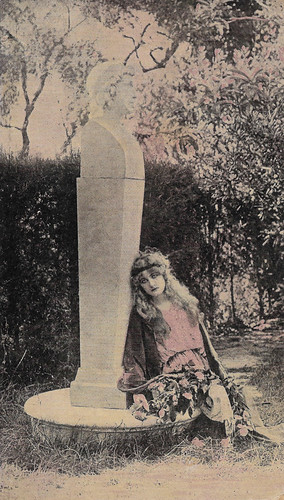
Spanish cromo by Chocolate Salas-Sabadell, no. 6 of 6 cards. Photo: Gaumont. Suzanne Delvé as the slave Callyce dreaming of her beloved Phidias in L'esclave de Phidias/The Slave of Phydias (Léonce Perret, 1917).
Sources: Maria Wyke (catalogue Cinema Ritrovato, Bologna, 2016), IMDb and the cards.
No comments:
Post a Comment